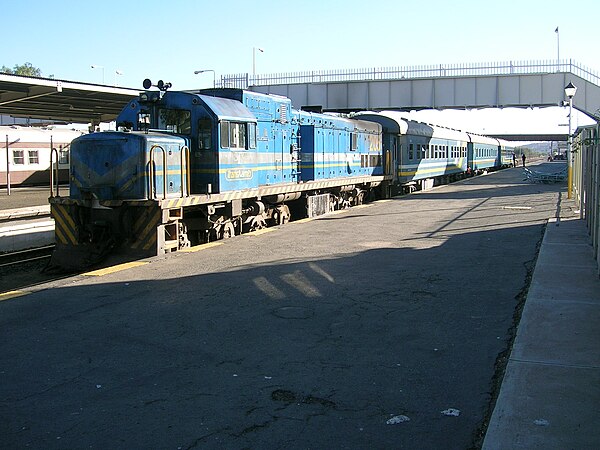South African Class 32-200
| South African Class 32-200 TransNamib Class 32 | |||||||||||||||||||||||||||||||||||||||||||||||||||||||||||||||||||||||||||||||||
|---|---|---|---|---|---|---|---|---|---|---|---|---|---|---|---|---|---|---|---|---|---|---|---|---|---|---|---|---|---|---|---|---|---|---|---|---|---|---|---|---|---|---|---|---|---|---|---|---|---|---|---|---|---|---|---|---|---|---|---|---|---|---|---|---|---|---|---|---|---|---|---|---|---|---|---|---|---|---|---|---|---|
 PPC Saldanha's no. 32-202, 8 January 2009 | |||||||||||||||||||||||||||||||||||||||||||||||||||||||||||||||||||||||||||||||||
| |||||||||||||||||||||||||||||||||||||||||||||||||||||||||||||||||||||||||||||||||
| |||||||||||||||||||||||||||||||||||||||||||||||||||||||||||||||||||||||||||||||||
| |||||||||||||||||||||||||||||||||||||||||||||||||||||||||||||||||||||||||||||||||
| |||||||||||||||||||||||||||||||||||||||||||||||||||||||||||||||||||||||||||||||||
The South African Railways Class 32-200 of 1966 was a diesel-electric locomotive.
In June and July 1966, the South African Railways placed ten Class 32-200 General Electric type U20C1 diesel-electric locomotives with a 1Co+Co1 wheel arrangement in service in South West Africa.[1][page needed]
Manufacturer
[edit]The Class 32-200 type GE U20C1 diesel-electric locomotive was designed and built to South African Railways (SAR) requirements by General Electric (GE) and imported. The ten locomotives were numbered in the range from 32-201 to 32-210.[1][page needed]
Class 32 series
[edit]The Class 32 consisted of two series, the high short hood Class 32-000 and the low short hood Class 32-200, both GE products and both with a 1Co+Co1 wheel arrangement. Both had single station controls.[1][page needed]

Both versions ran on the same 1Co' bogies, three-axle Co' bogies with additional integral single axle pony trucks which was designed and produced by General Steel Castings. The fourth axle reduced the maximum axle loading sufficiently to enable these relatively heavy locomotives to operate on the very light rail which was used throughout South West Africa at the time.[2][page needed]
The Class 32-200 was a more powerful low short hood version of the earlier Class 32-000 and was essentially a Class 33-000 locomotive on the bogies of the Class 32-000. This reduced its maximum axle load from the 15,749 kilograms (34,721 pounds) of the Class 33-000 to 12,700 kilograms (27,999 pounds). Apart from the bogies which necessitated a smaller fuel tank, its physical dimensions and exterior appearance were identical to that of the Class 33-000 and it used the same V12 prime mover.[1][page needed]
Service
[edit]South African Railways
[edit]While it was acquired specifically for service on light rail in South West Africa, the Class 32-200s also ended up being employed in South Africa at times. From 1972 to 1974, between the withdrawal of the Class GO 4-8-2+2-8-4 Garratt locomotives and the arrival of the Class 35-000 diesel-electrics on the line between Amabele and Umtata in Transkei, some of them performed temporary service on that line.[3]
Post-SAR service
[edit]All ten locomotives survived and most were still in service by 2014.[4][5]
- Numbers 32-201 and 32-203 are with Sheltam, renumbered 2012 and 2013, and have been working in Welkom.
- No. 32-202 works at the Pretoria Portland Cement lime plant in Saldanha.
- No. 32-204 works between the New Clydesdale Colliery near Witbank and the Transnet Freight Rail sidings at Bezuidenhoutsrust.
- Numbers 32-205 to 32-208 are still with TransNamib, the Namibian railway, renumbered 205 to 208 and with a couple believed to still be in regular use.
- Numbers 32-209 and 32-210 were sold to Sudan Railways.
Liveries
[edit]The class 32-000 were delivered in the new Gulf Red livery with yellow side-stripes on the long hood and a yellow V on each end. They wore this livery throughout their SAR service life.[6]
Works numbers
[edit]The Class 32-200 builder's works numbers and disposition are listed in the table.[4][5]
SAR no. |
GE works no. |
Post-SAR owner |
Post-SAR no. |
|---|---|---|---|
| 32-201 | 35842 | Sheltam | 2012 |
| 32-202 | 35843 | PPC | |
| 32-203 | 35844 | Sheltam | 2013 |
| 32-204 | 35845 | New Clydesdale | |
| 32-205 | 35846 | TransNamib | 205 |
| 32-206 | 35847 | TransNamib | 206 |
| 32-207 | 35848 | TransNamib | 207 |
| 32-208 | 35849 | TransNamib | 208 |
| 32-209 | 35850 | Sudan Railways | |
| 32-210 | 35851 | Sudan Railways |
Illustration
[edit]-
TransNamib's no. 205 at Windhoek station, Namibia, 26 June 2010
References
[edit]- ^ a b c d South African Railways Index and Diagrams Electric and Diesel Locomotives, 610mm and 1065mm Gauges, Ref LXD 14/1/100/20 (amended ed.). 28 January 1975.
- ^ Steinbrenner, Richard T. (2003). The American Locomotive Company: A Centennial Remembrance. Warren, NJ: On Track Publishers, LLC. ISBN 0911122-07-9.
- ^ Paxton, Leith; Bourne, David (1985). Locomotives of the South African Railways (1st ed.). Cape Town: Struik. pp. 138–139. ISBN 0869772112.
- ^ a b Middleton, John N. (2002). Railways of Southern Africa Locomotive Guide - 2002 (as amended by Combined Amendment List 4, January 2009) (2nd, Dec 2002 ed.). Herts, England: Beyer-Garratt Publications. pp. 38, 45, 47, 66.
- ^ a b "SAR-L Yahoogroup message no. 47981". 17 October 2014. Retrieved 18 May 2017.[unreliable source?]
- ^ Pivnic, Les. "System 7, Western Transvaal, based in Johannesburg, Part 6. Germiston, the Steam and Diesel Running Sheds". Soul of A Railway. Captions 5, 33, 36. Retrieved 7 April 2017.

